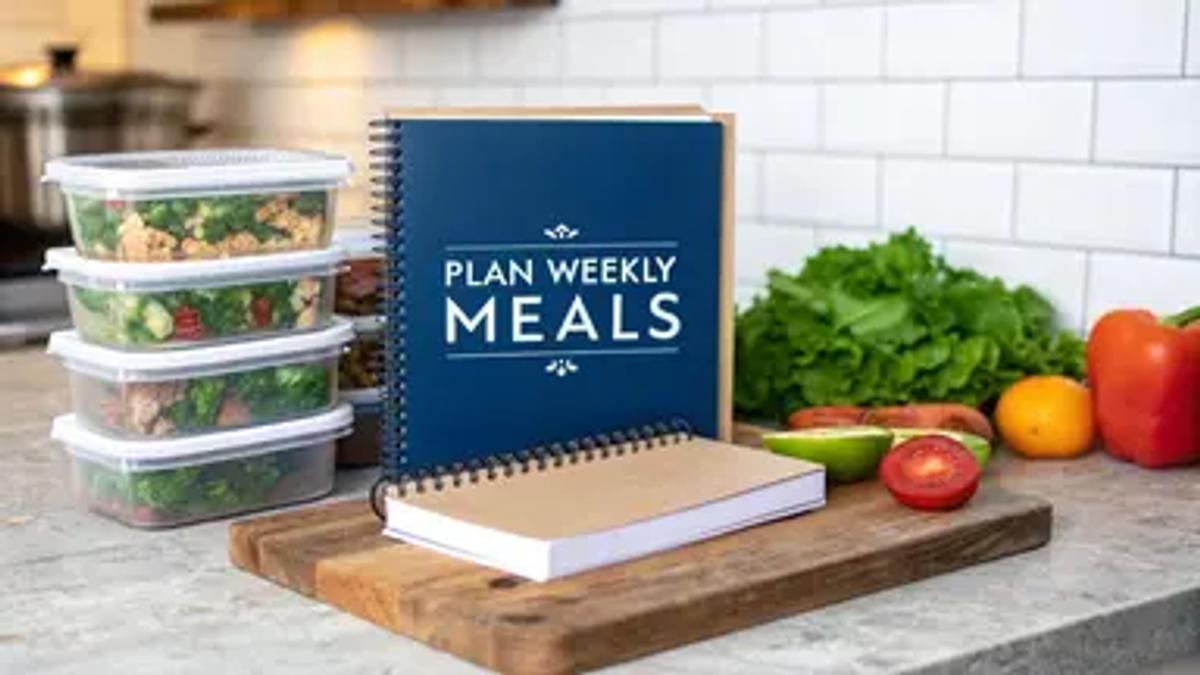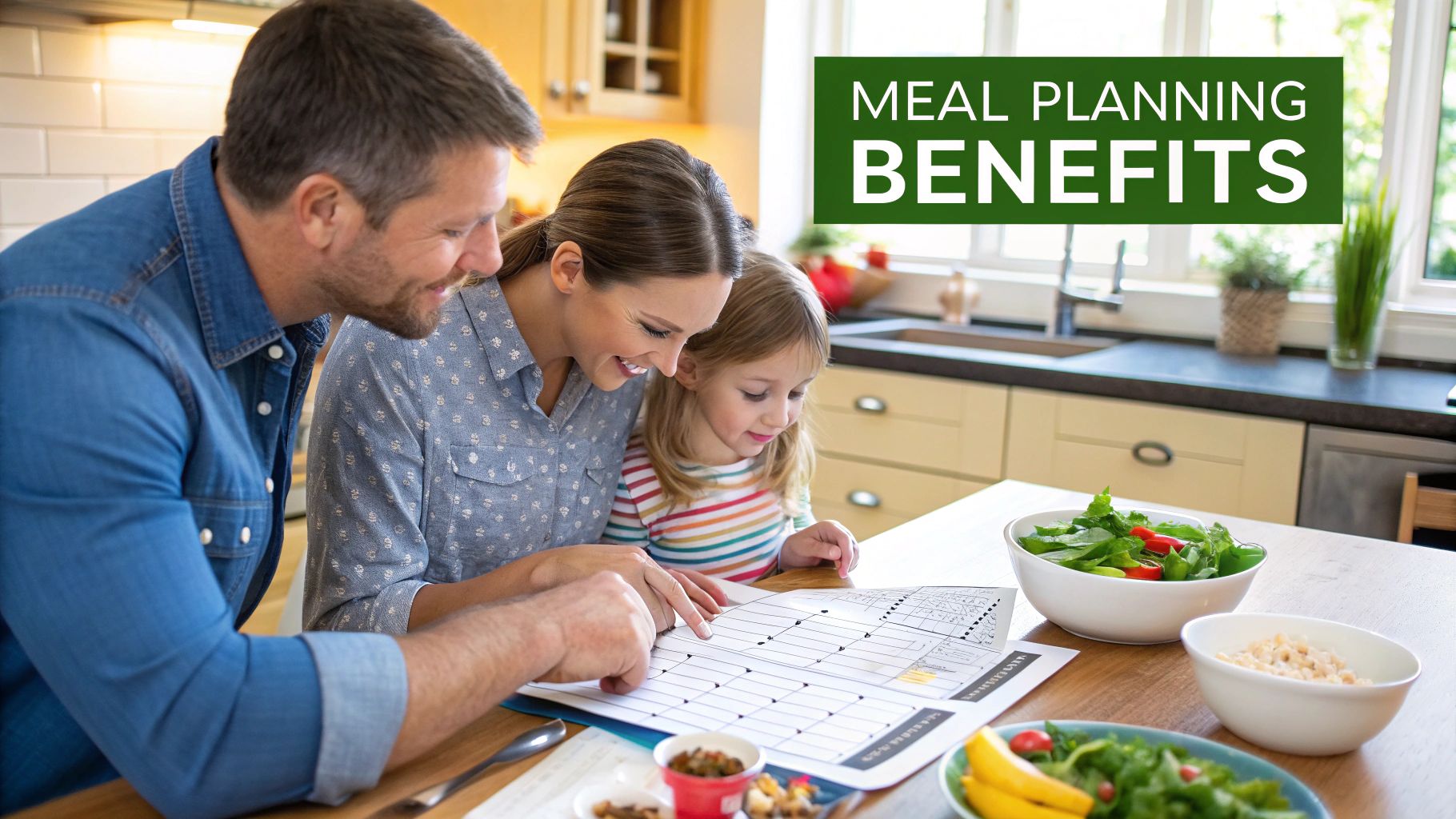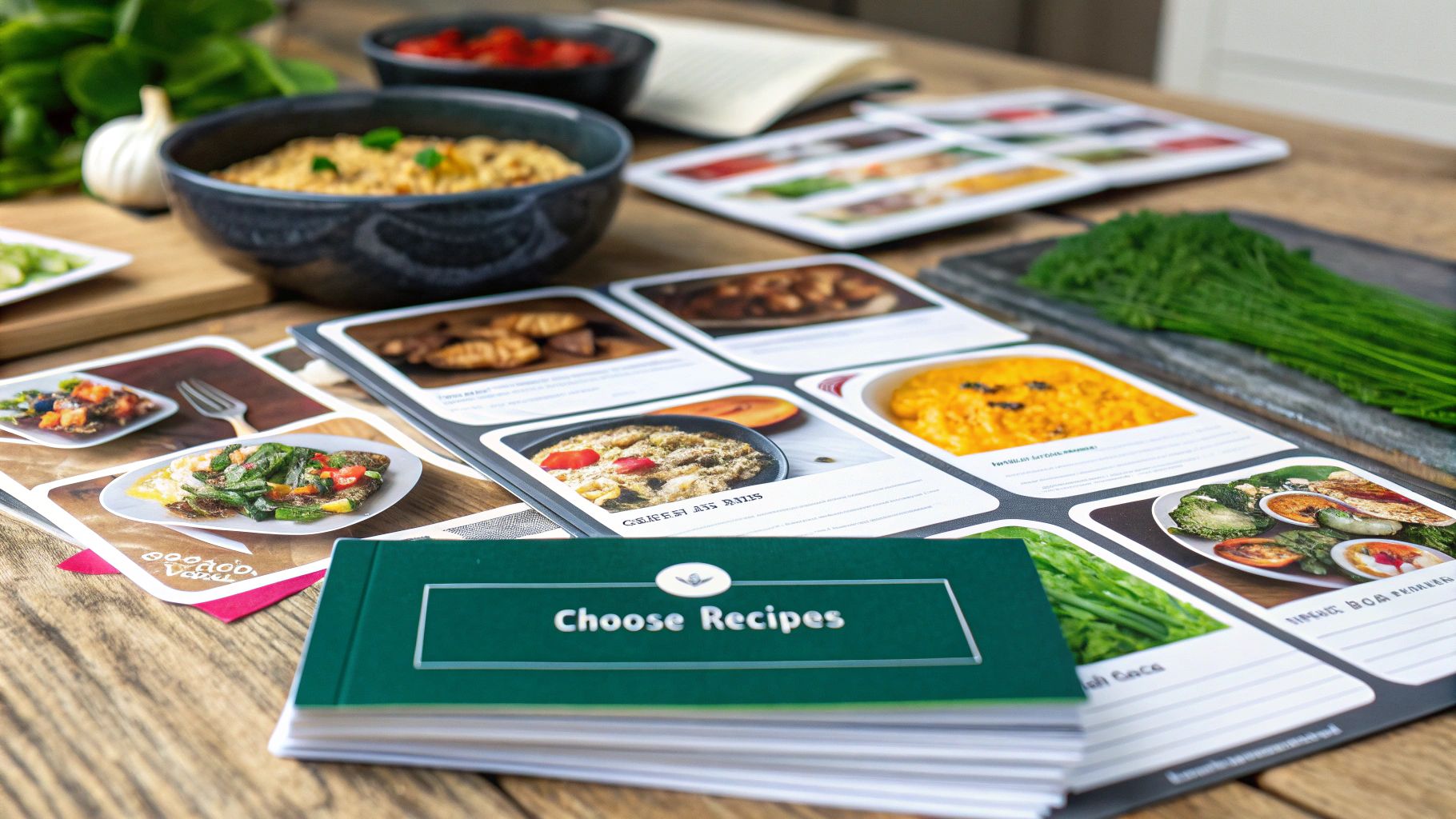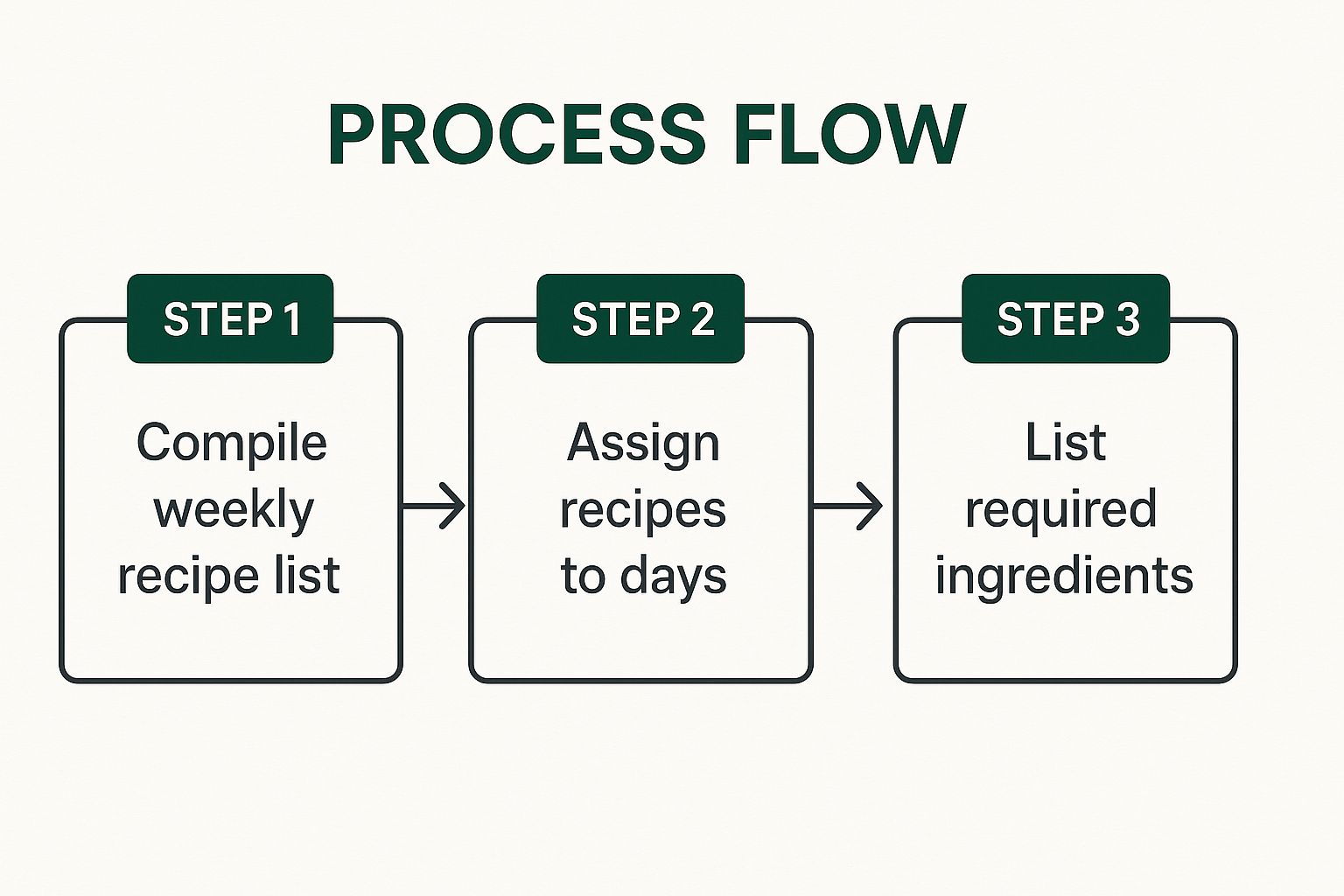How to Plan Weekly Meals and Reclaim Your Week
Learn how to plan weekly meals with this guide. Discover a stress-free system for recipe planning, smart shopping, and easy prep to save time and money.
Ready to Simplify Your Meal Planning?
Get personalized meal plans and grocery lists automatically matched to your macro targets.

How to Plan Weekly Meals and Reclaim Your Week
Tired of the nightly "what's for dinner?" scramble? I get it. For years, that was my reality, too. The real secret to breaking that cycle isn't some complicated system; it's a simple, repeatable rhythm.
You just need to figure out your goals, pull together your go-to recipes, sketch out your dinners for the week, and then build a shopping list that actually makes sense. That’s it. This simple framework is what turns mealtime chaos into a feeling of calm control, saving you a surprising amount of money and stress along the way.
Why Weekly Meal Planning Is Your Kitchen Superpower
Let's be real: the constant mental gymnastics of figuring out what to eat is draining. A good meal plan isn't about eating boring food or sticking to a rigid, joyless schedule. Think of it as a flexible roadmap for your week, one that guides you past the daily panic attacks in front of an open fridge.
By setting aside just 30-60 minutes once a week, you can wave goodbye to those frantic, last-minute trips to the store. You'll stop making impulse buys (we all know how those happen) and finally start using up the ingredients you already own. This is your ticket to a more organized kitchen, a less wasteful life, and honestly, a healthier you.
The Actual, Real-Life Payoffs
When you finally commit to planning, you get so much more than just an organized fridge. You’re building a system that works for your entire household, not against it.
- Slash Your Grocery Bill: When you shop with a purpose, you stop buying random stuff you don't need. It’s that simple.
- Drastically Reduce Food Waste: A plan gives every single ingredient a job, which means way less forgotten, wilted produce in the back of your crisper.
- Make Healthy Eating the Easy Choice: It's a whole lot easier to stick to your health goals when delicious, nutritious meals are already planned out and waiting for you.
- Take Back Your Weeknights: Imagine walking in the door after a long day and knowing exactly what's for dinner. No stress. No debate. Just cooking.
This isn't just about pen and paper anymore. The game has changed, and smart, digital tools are making this whole process easier than ever.
The Digital Makeover for Meal Planning
These days, technology is stepping in to make planning your weekly meals almost ridiculously simple. For busy families juggling different tastes, dietary needs, and chaotic schedules, digital tools are becoming the new command center for all things food.
In fact, a 2025 survey showed that over 67% of adults aged 25 to 45 are already using digital meal planners or grocery list apps at least twice a week. If you're curious, you can check out some of the top meal planning apps to see how they might fit into your own life.
Find Your Personal Meal Planning Style

Before you even think about recipes, we need to talk about you. Trying to force yourself into a meal planning system that doesn't fit your life is a recipe for disaster. It’s like trying to navigate without a map—you’ll get somewhere, but probably not where you wanted to go.
So, let's get real. Why are you doing this? Are you a budget warrior trying to wrestle your grocery bill into submission? A health nut on a mission for clean eating? Or maybe you're a busy parent just trying to survive the 5 PM "what's for dinner?!" chaos.
Whatever your reason, that's your starting point. It shapes every decision you'll make from here on out.
What’s Your Meal Planning Personality?
There is no magical, one-size-fits-all meal plan. The secret to a system that you'll actually stick with is finding one that feels natural, not like another dreaded chore on your to-do list.
Let's see if you recognize yourself in one of these common styles:
- The Sunday Batch Cooker: You live for efficiency. Your happy place is a kitchen filled with the sounds of chopping and sizzling on a Sunday afternoon, stocking the fridge with grab-and-go meals for the week. Weeknights become a simple heat-and-eat dream.
- The Flexible Planner: You like a little structure, but you also need freedom. You'll happily make a list of approved meals for the week, but you want to decide what you're in the mood for each day. No rigid schedules for you.
- The Theme Night Champion: You're all about fun and predictability. Your week is a delicious routine: Meatless Monday, Taco Tuesday, Pizza Friday. It takes the guesswork out of planning and gives everyone something to look forward to.
- The Budget Optimizer: Your decisions are driven by your wallet. You're a master at planning meals around weekly sales flyers, seasonal produce, and what’s already hiding in your pantry. Your goal is maximum savings, minimum waste.
Finding your style is the most important step. A plan that doesn’t align with your personality or schedule is a plan that’s destined to fail. Be honest about your time, energy, and what you genuinely enjoy.
Get Real About Your Week
Once you've identified your general vibe, it’s time for a reality check. What does your actual week look like? Take a hard look at your family’s schedule. Late night soccer practice on Tuesdays? That's not the night to attempt a three-course meal.
And don't forget the human element—you know, the picky eaters, the allergies, the "I don't like that" chorus. These little details are what turn a generic plan into your plan.
This whole movement toward personalized, health-focused eating is huge right now. The global meal planning app market was valued at USD 1.2 billion in 2023 and is projected to explode to nearly USD 3.6 billion by 2032. It just goes to show that people everywhere want to take control of their health through food, and a good plan is the first step. You can dig deeper into these developing market trends if you're curious.
This is exactly where tools like **Meal Flow AI** come in handy. You can plug in all those unique needs—the dietary restrictions, the picky-eater preferences, the chaotic schedule—and it helps create a plan that feels like it was made just for you.
By figuring out your "why" and getting honest about your real-world needs, you're building a foundation for a meal plan that brings relief, not more stress.
Build Your Go-To Recipe Arsenal

Here’s a little secret from someone who's been in the meal planning trenches for years: the key isn't finding a shiny, new, complicated recipe every single night. That's a one-way ticket to burnout. The real magic lies in building a trusted collection of go-to meals you can always fall back on.
Think of it as your kitchen’s greatest hits album—a playlist of recipes your family actually gets excited about. This isn’t just another chaotic Pinterest board; it's a powerhouse arsenal of tried-and-true favorites that becomes the backbone of your entire plan. Getting this right turns the "what's for dinner?" debate from an hour-long ordeal into a five-minute decision.
Create Your "Can't-Fail" Collection
First things first, let's round up the current crowd-pleasers. What meals get requested on a loop? What can you practically cook with your eyes closed? Your first mission is to jot down about 10-15 core meals that are guaranteed wins.
These are your foundation. They’re the meals you’ll sprinkle throughout the month, saving you on those nights when your brain is just done.
- Family Favorites: Get the whole crew involved. In my house, that’s taco night (always) and a simple roasted chicken.
- Quick Weeknight Wins: What can you get on the table in 30 minutes or less? Think sheet-pan sausages or a quick pasta dish.
- Budget-Friendly Staples: Don't forget the meals that are kind to your wallet. For us, that means lentil soup or hearty rice and bean bowls.
Your recipe arsenal is a living, breathing thing. It should grow and change as your family's tastes evolve and your cooking confidence blossoms. Don't be afraid to retire a recipe that's lost its spark and swap in a new favorite.
Organize for Quick-Draw Access
Once you have your list, you need a system. It doesn't matter if it's a fancy app, a three-ring binder with plastic sleeves, or a bunch of notes on your phone. The best system is the one you’ll actually use.
A messy pile of recipes is just as stressful as having none at all. The goal is to make them easy to scan when you sit down to plan your week.
Finding (and Vetting) New Hits
To keep things from getting stale, I like to follow a simple rule: try one new recipe each week. This is the perfect way to prevent mealtime boredom without completely overwhelming yourself. If the new dish is a hit? It gets promoted and officially added to the arsenal.
This is where a tool like **Meal Flow AI** can be a total game-changer. Instead of me doomscrolling for hours looking for inspiration, it suggests new recipes that actually fit my family’s preferences and dietary needs. It completely takes the guesswork out of finding new dishes that won't get rejected by my picky eaters.
For instance, if I know my family is in the mood for chicken, but I need a dairy-free meal that takes under 40 minutes, I can plug those exact requirements in. The AI does the heavy lifting, serving up options that fit my life, rather than forcing me to sift through thousands of duds. It makes growing your recipe collection feel intentional and, best of all, successful.
Design Your Weekly Menu and Smart Shopping List
Alright, you’ve got your arsenal of go-to recipes. Now for the fun part: turning that collection of delicious ideas into a real, honest-to-goodness weekly plan. This isn't about creating a rigid, unbreakable schedule. Think of it more as a flexible game plan that brings a little bit of sanity back to your week.
The idea is simple. You take the recipes you've gathered and start plugging them into your weekly calendar. This is your chance to get strategic and make your future self very, very happy.
Map Out Your Week
First things first, pull up your calendar. What does your week actually look like?
Got a late night at the office on Wednesday? That’s a perfect spot for that 30-minute skillet meal or, even better, planned leftovers. Have a little more breathing room on Friday night? Maybe that's when you finally tackle that new curry recipe you’ve been eyeing.
A trick I’ve leaned on for years is theme nights. It’s a classic for a reason—it just works. It completely wipes out that "what's for dinner?" paralysis.
- Meatless Monday: A great way to ease into the week with something light and healthy, like a big lentil soup or some black bean burgers.
- Taco Tuesday: Need I say more? It’s a guaranteed crowd-pleaser and so easy to customize for picky eaters.
- Pasta Wednesday: Whether it's a simple spaghetti aglio e olio or a baked ziti you prepped on the weekend, pasta night is always a comforting win.
- Flex Friday: Give yourself a break! This night is for clearing out leftovers, grabbing a meal from the freezer, or just ordering a pizza. No shame in that game.
This whole process is a logical flow, from picking your meals to getting organized for the grocery run.

As you can see, a solid plan moves you seamlessly from one step to the next, turning your recipe ideas into a concrete menu and then into a shopping list that actually makes sense.
The single best thing you can do? Plan for leftovers. Seriously. Roast a whole chicken on Sunday, and you've got the makings for chicken salad sandwiches on Tuesday. It’s the ultimate “cook once, eat twice” strategy.
Turn Your Menu Into a Smart Shopping List
Once your meals are penciled in, creating the shopping list is a breeze. Just walk through your menu, day by day, and jot down every ingredient you need. This is how you transform your plan into a focused mission at the grocery store.
Do yourself a huge favor and organize that list by store section: produce, dairy, meat, pantry, etc. This simple step stops you from doing frantic laps around the store and saves you from those tempting impulse buys at the checkout. A well-organized list is your best friend.
This entire process, from finding recipes to sorting your grocery list, is getting a massive boost from new technology. And this isn't just a niche trend; the market for AI meal planning apps is expected to jump from $0.67 billion in 2024 to $0.83 billion in 2025. That kind of growth shows just how much people want tools that can take the grunt work out of meal planning. You can dig into the numbers yourself by checking out the latest insights on the AI-driven meal planning market.
The difference between the old way and the new way is pretty stark.
Traditional vs AI-Powered Meal Planning
| Planning Step | Traditional Method | AI-Powered Method |
| Recipe Discovery | Flipping through cookbooks, browsing blogs, searching Pinterest. | Get instant, personalized recipe suggestions based on your tastes. |
| Menu Scheduling | Manually writing or typing meals into a calendar. | Drag-and-drop recipes onto a digital calendar, often with smart suggestions. |
| Ingredient List | Manually writing down every single ingredient from each recipe. | Automatically generates a combined, categorized shopping list. |
| List Organization | Rewriting your list to group items by store aisle. | Your list is instantly sorted by aisle (produce, dairy, etc.). |
| Shopping | Checking off items on a paper or phone list, often forgetting things. | Sync your list across devices; check off items as you shop. |
As you can see, what used to be an hour-long chore can now be done in minutes, freeing you up to focus on the enjoyable parts—like actually cooking and eating.
Execute Your Meal Prep Like a Pro

Okay, let's be real. A great plan is just a good idea until you actually do something with it. This is where the magic happens—turning that brilliant menu you designed into a fridge full of ready-to-go meal parts. Welcome to your prep day, the secret weapon in your quest to finally master weekly meal planning.
Your mission, should you choose to accept it, is not to cook five complete dinners on a Sunday afternoon. That’s a one-way ticket to burnout city. Instead, you're going to embrace the art of component prepping.
Think of it as becoming the sous chef for your future, frazzled self. By getting all the annoying little tasks out of the way now, you make weeknight dinners a simple, almost effortless assembly job.
Smart Prepping That Actually Saves Time
The goal here is to work smarter, not harder. You want to zero in on the tasks that give you the biggest bang for your buck during the week. Seriously, just chopping all your onions at once is a total game-changer.
Here's what a solid prep session might look like:
- Chop All The Veggies: Get your onions, bell peppers, carrots, and celery diced, sliced, and ready to roll. Store them in airtight containers, and you've just saved yourself 10-15 minutes of tedious chopping every single night.
- Wash & Dry Your Greens: Give that lettuce or kale a good wash, spin it bone-dry, and store it with a paper towel to keep it crisp. Salads are now just a toss away.
- Get Your Grains Going: Make a big pot of rice, quinoa, or even pasta. These are the unsung heroes of the week, perfect as a side dish, the base for a grain bowl, or bulking up a soup.
- Marinate Your Proteins: Tossing some chicken, beef, or tofu in a ziplock bag with a flavorful marinade takes about two minutes. The payoff in taste and tenderness is huge.
Look, don't feel like you have to do it all. Even 30 minutes of focused prep can completely transform your weeknights. Start small. Maybe just chop the veggies and cook a grain. You can build from there.
This whole approach turns cooking from a nightly chore into a quick, creative burst. You’re not starting from zero every evening; you’re just pulling together your prepped components.
Keep It Fresh, Keep It Functional
Of course, all that gorgeous prep work is worthless if it turns into a science experiment in your fridge by Tuesday. Proper storage is everything. A good set of clear, airtight containers is a non-negotiable investment. Trust me, seeing what you have is half the battle against food waste.
I like to create a dedicated "meal prep zone" on one shelf in my fridge. All my little containers of chopped veggies, cooked grains, and marinated meats live there together. When it's time to cook, I just grab that night's ingredients. No more frantic digging behind last week's takeout.
A Real-World Prep Day in Action
Let's imagine your plan includes chicken stir-fry, taco bowls, and a big salmon salad. Here’s how you’d tackle that on prep day:
| Meal Component | Prep Day Action | Weeknight Use |
| Protein | Cube the chicken for the stir-fry. Brown the ground beef for tacos. | Chicken is ready for the wok. Beef just needs a quick reheat. |
| Vegetables | Chop peppers, onions, and broccoli for the stir-fry. Dice tomatoes and shred lettuce for tacos. | Veggies go straight into the pan or bowl. No chopping needed! |
| Grains | Cook a large batch of white or brown rice. | Serve alongside the stir-fry and as the base for the taco bowls. |
| Sauces | Whisk together a simple stir-fry sauce. Mix up a batch of cilantro-lime dressing for the salad. | Adds instant flavor without the mess of starting from scratch. |
By knocking this out in about 90 minutes on a Sunday, you’ve basically done 80% of the work for three different meals. That, my friends, is how you reclaim your weeknights. It isn't about rigid rules; it's about giving yourself the gift of time and sanity.
Alright, let's tackle those nagging questions that always seem to crop up once you get into the swing of meal planning. Even the most seasoned planners hit a wall sometimes, so if you're feeling stuck, you're in good company.
Think of this as your personal FAQ for when the best-laid plans go a little sideways. We've all been there.
What If I Don’t Have Time for a Big Prep Day?
This is probably the biggest myth I hear about meal planning: the idea that you have to sacrifice an entire Sunday to the kitchen gods. Let me be clear—you absolutely do not.
Forget the massive, all-day batch cooking session. Instead, look for tiny pockets of time you already have. Chopping an onion while your coffee brews in the morning? That’s meal prep. Washing and spinning your salad greens for the week while the kids are (supposedly) doing their homework? That’s meal prep, too.
Key Takeaway: Stop thinking of "meal prep" as a single, monumental event. Even 15-20 minutes of focused work, like throwing some chicken in a marinade or cooking a batch of quinoa, can be a total game-changer for your weeknights.
How Do I Handle Picky Eaters?
Ah, the classic dinnertime dilemma. If you've got a picky eater (or three) at your table, you know the struggle is real. But listen closely: the answer is not to become a short-order cook. That's a one-way ticket to burnout city.
The secret is building your meals around customizable components. Think "deconstructed."
- Taco Night: This is the gold standard. Lay out all the toppings—seasoned meat, beans, cheese, lettuce, salsa, sour cream—and let everyone build their own masterpiece.
- Pasta Night: Simply serve the sauce and other goodies on the side. One kid wants plain buttered noodles? Fine. You want to load yours up with bolognese and parmesan? Go for it.
- Pizza Friday: Give each person a mini crust or a piece of naan bread. Set out the sauce, cheese, and a few toppings, and let them get creative.
This approach gives everyone, especially kids, a little bit of control. It guarantees there's something on their plate they'll actually eat, and you only had to cook one core meal.
How Do I Stay Motivated When I Get Bored?
It happens to the best of us. That initial burst of "I'm so organized!" energy fades, and suddenly, that meal plan you were so proud of feels… well, boring. Like a culinary cage.
The trick is to bake novelty right into your routine, but in a manageable way.
My go-to rule is simple: try one new recipe a week. That’s it. It’s a low-stakes way to explore new flavors without feeling like you have to reinvent the wheel. If the new dish is a smash hit, fantastic! It gets added to your trusted rotation. If it’s a dud, no biggie—you just go back to your old standbys the following week. That tiny bit of newness is usually all it takes to keep things from feeling stale.
---
Feeling like you're constantly juggling picky eaters, a packed schedule, and a tight budget? Let Meal Flow AI take a load off your plate. Our platform whips up personalized meal plans that actually fit your family's tastes and spits out a ready-to-go shopping list. Ditch the mealtime stress and see how simple it can be at Meal Flow AI.